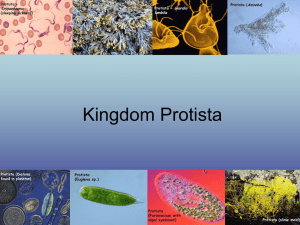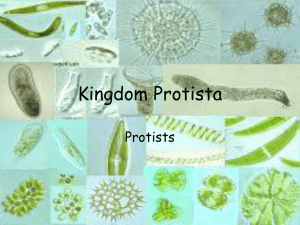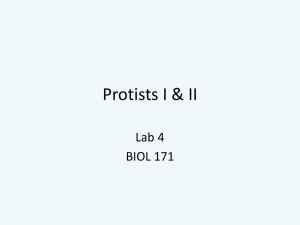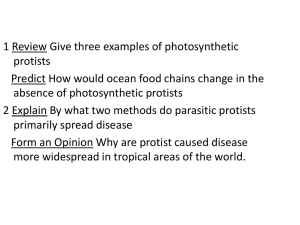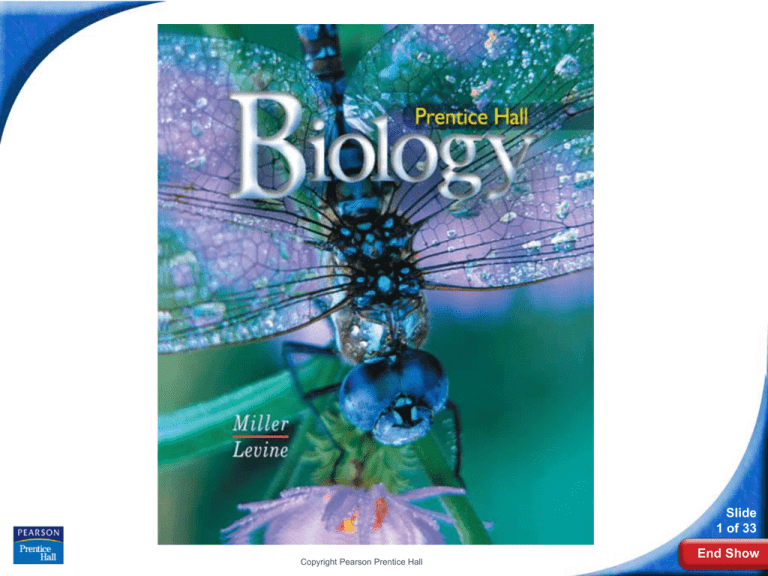
biology
Slide
1 of 33
Copyright Pearson Prentice Hall
End Show
20-3 Plantlike Protists:
Unicellular Algae
Slide
2 of 33
Copyright Pearson Prentice Hall
End Show
20-3 Plantlike Protists:
Unicellular Algae
Plantlike Protists
Plantlike protists contain chlorophyll and carry out
photosynthesis.
Plantlike protists are commonly called “algae.”
Algae are sometimes classified with the plants.
Slide
3 of 33
Copyright Pearson Prentice Hall
End Show
20-3 Plantlike Protists:
Unicellular Algae
Plantlike Protists
The four phyla of unicellular algae are:
• euglenophytes
• chrysophytes
• diatoms
• dinoflagellates
Slide
4 of 33
Copyright Pearson Prentice Hall
End Show
20-3 Plantlike Protists:
Unicellular Algae
Chlorophyll and Accessory
Pigments
Chlorophyll and Accessory Pigments
What is the function of chlorophyll and
accessory pigments in algae?
Slide
5 of 33
Copyright Pearson Prentice Hall
End Show
20-3 Plantlike Protists:
Unicellular Algae
Chlorophyll and Accessory
Pigments
Chlorophyll and accessory pigments allow
algae to harvest and use the energy from
sunlight.
Slide
6 of 33
Copyright Pearson Prentice Hall
End Show
20-3 Plantlike Protists:
Unicellular Algae
Chlorophyll and Accessory
Pigments
One trait used to classify algae is the type of
photosynthetic pigments they contain.
Slide
7 of 33
Copyright Pearson Prentice Hall
End Show
20-3 Plantlike Protists:
Unicellular Algae
Chlorophyll and Accessory
Pigments
Some algae have evolved different forms of
chlorophyll—a, b, and c—that absorb different
wavelengths of light.
Accessory pigments absorb light at different
wavelengths than chlorophyll, giving algae a variety
of colors.
Slide
8 of 33
Copyright Pearson Prentice Hall
End Show
20-3 Plantlike Protists:
Unicellular Algae
Euglenophytes
Euglenophytes
What are the distinguishing features of the
euglenophytes?
Slide
9 of 33
Copyright Pearson Prentice Hall
End Show
20-3 Plantlike Protists:
Unicellular Algae
Euglenophytes
Euglenophytes are plantlike protists that
have two flagella but no cell wall.
Slide
10 of 33
Copyright Pearson Prentice Hall
End Show
20-3 Plantlike Protists:
Unicellular Algae
Euglenophytes
Pellicle
Euglena
Carbohydrate
storage bodies
Contractile vacuole
Chloroplast
Nucleus
Eyespot
Gullet
Flagella
Slide
11 of 33
Copyright Pearson Prentice Hall
End Show
20-3 Plantlike Protists:
Unicellular Algae
Euglenophytes
Two flagella emerge from
a gullet in the cell. The
longer of the flagella
spins so it pulls the
organism rapidly through
the water.
Gullet
Flagella
Slide
12 of 33
Copyright Pearson Prentice Hall
End Show
20-3 Plantlike Protists:
Unicellular Algae
Euglenophytes
Near the gullet is a
reddish pigment known
as the eyespot, which
helps find sunlight to
power photosynthesis.
Euglenas can also live as
heterotrophs.
Eyespot
Slide
13 of 33
Copyright Pearson Prentice Hall
End Show
20-3 Plantlike Protists:
Unicellular Algae
Euglenophytes
Euglenas store
carbohydrates in small
storage bodies.
Carbohydrate
storage bodies
Slide
14 of 33
Copyright Pearson Prentice Hall
End Show
20-3 Plantlike Protists:
Unicellular Algae
Euglenophytes
Euglenas do not have
cell walls. Instead, they
have an intricate cell
membrane called a
pellicle.
Pellicle
The pellicle folds into
ridges, each supported
by microtubules.
Slide
15 of 33
Copyright Pearson Prentice Hall
End Show
20-3 Plantlike Protists:
Unicellular Algae
Euglenophytes
Euglenas reproduce asexually by binary
fission.
Slide
16 of 33
Copyright Pearson Prentice Hall
End Show
20-3 Plantlike Protists:
Unicellular Algae
Chrysophytes
Chrysophytes
What are the distinguishing features
of the chrysophytes?
Slide
17 of 33
Copyright Pearson Prentice Hall
End Show
20-3 Plantlike Protists:
Unicellular Algae
Chrysophytes
Members of the phylum Chrysophyta
are a diverse group of plantlike protists
that have gold-colored chloroplasts.
Slide
18 of 33
Copyright Pearson Prentice Hall
End Show
20-3 Plantlike Protists:
Unicellular Algae
Chrysophytes
The cell walls of some chrysophytes contain the
carbohydrate pectin rather than cellulose, and others
contain both.
Chrysophytes store food in the form of oil rather than
starch.
They reproduce both asexually and sexually.
Most are solitary, but some form threadlike colonies.
Slide
19 of 33
Copyright Pearson Prentice Hall
End Show
20-3 Plantlike Protists:
Unicellular Algae
Diatoms
Diatoms
What are the distinguishing features
of the diatoms?
Slide
20 of 33
Copyright Pearson Prentice Hall
End Show
20-3 Plantlike Protists:
Unicellular Algae
Diatoms
Diatoms produce thin, delicate cell walls
rich in silicon (Si)—the main component of
glass.
The walls are shaped like the two sides of a
petri dish or flat pillbox, with one side fitted
snugly into the other.
Slide
21 of 33
Copyright Pearson Prentice Hall
End Show
20-3 Plantlike Protists:
Unicellular Algae
Dinoflagellates
Dinoflagellates
What are the distinguishing features
of the dinoflagellates?
Slide
22 of 33
Copyright Pearson Prentice Hall
End Show
20-3 Plantlike Protists:
Unicellular Algae
Dinoflagellates
About half of the dinoflagellates are
photosynthetic; the other half live as
heterotrophs.
Slide
23 of 33
Copyright Pearson Prentice Hall
End Show
20-3 Plantlike Protists:
Unicellular Algae
Dinoflagellates
Dinoflagellates have two flagella that fit in grooves
between two thick plates of cellulose that protect the
cell.
Most dinoflagellates reproduce asexually by binary
fission.
Many dinoflagellates are luminescent. When they are
agitated, they give off light.
Slide
24 of 33
Copyright Pearson Prentice Hall
End Show
20-3 Plantlike Protists:
Unicellular Algae
Ecology of Unicellular Algae
Ecology of Unicellular Algae
Plantlike protists are important to freshwater and
marine ecosystems because they make up the
base of the food chain in many aquatic
ecosystems.
Slide
25 of 33
Copyright Pearson Prentice Hall
End Show
20-3 Plantlike Protists:
Unicellular Algae
Ecology of Unicellular Algae
Phytoplankton constitute the population of small,
photosynthetic organisms found near the surface of
the ocean.
Phytoplankton carry out half of Earth’s
photosynthesis. In addition, they provide nourishment
for many organisms.
Slide
26 of 33
Copyright Pearson Prentice Hall
End Show
20-3 Plantlike Protists:
Unicellular Algae
Ecology of Unicellular Algae
Algal Blooms
Many protists are vital in recycling sewage and
other wastes.
When waste is excessive, algae may grow into
enormous masses known as blooms, which
deplete water of nutrients.
Their decomposition robs water of oxygen, killing
fish and invertebrate life.
Slide
27 of 33
Copyright Pearson Prentice Hall
End Show
20-3
Click to Launch:
Continue to:
- or -
Slide
28 of 33
End Show
Copyright Pearson Prentice Hall
20-3
The function of accessory pigments in various
groups of algae is to
a. absorb red and violet light.
b. carry out photosynthesis in the absence of
chlorophyll.
c. increase the range of wavelengths used for
photosynthesis.
d. carry out photosynthesis when sunlight is not
available.
Slide
29 of 33
End Show
Copyright Pearson Prentice Hall
20-3
Which of the following describes structures
found in euglenophytes?
a. chloroplasts but no cell walls
b. chloroplasts and cell walls
c. cell walls but no chloroplasts
d. no cell walls or chloroplasts
Slide
30 of 33
End Show
Copyright Pearson Prentice Hall
20-3
Plantlike protists with gold-colored chloroplasts
are the
a. euglenophytes.
b. diatoms.
c. chrysophytes.
d. dinoflagellates.
Slide
31 of 33
End Show
Copyright Pearson Prentice Hall
20-3
The base of most marine food chains is made
up of
a. zooplankton.
b. euglenophytes.
c. phytoplankton.
d. chrysophytes.
Slide
32 of 33
End Show
Copyright Pearson Prentice Hall
20-3
The effect of algal “blooms” on other organisms is that
they
a. poison consumers that eat filter-feeders such as
clams.
b. serve as an important food source for fish and
crustaceans.
c. decompose dead and decaying organisms.
d. convert inorganic molecules into energy-rich food
molecules.
Slide
33 of 33
End Show
Copyright Pearson Prentice Hall
END OF SECTION



